
The Szeged mRNA Conference, featuring the world’s leading experts in mRNA research, took place on November 7–8, 2024, at the József Attila Study and Information Centre of the University of Szeged. Sponsored by the Novo Nordisk Foundation and hosted by the University of Szeged, the event showcased the groundbreaking work of 15 scientists in the field of mRNA technology. For those unable to attend, this article offers key insights from engaging talks by Drew Weissman, Karin Loré, Antal Nógrádi, Uğur Şahin, Robin Shattock, Persephone Borrow, and Tamás Kiss. To ensure that each research topic is presented accurately, PhD students from the University of Szeged’s Institute of Biology assisted the university press team throughout the writing process.
Compared to its scope of applications, “It’s easier to list the medical fields where mRNA technology won’t be applied,” said Drew Weissman, Nobel Prize-winning microbiologist and vaccine researcher, during the press event for the mRNA Conference in Szeged. This statement was backed up by the talks delivered at the international symposium, revealing that the speakers invited by Katalin Karikó foster professional ties with one another and are familiar with the discoveries made by their colleagues. However, for many in the audience, this was their first opportunity to hear about the latest research – the interconnectedness of which indicates that the development of mRNA-based vaccines and therapies is fueled by dedicated international collaboration.
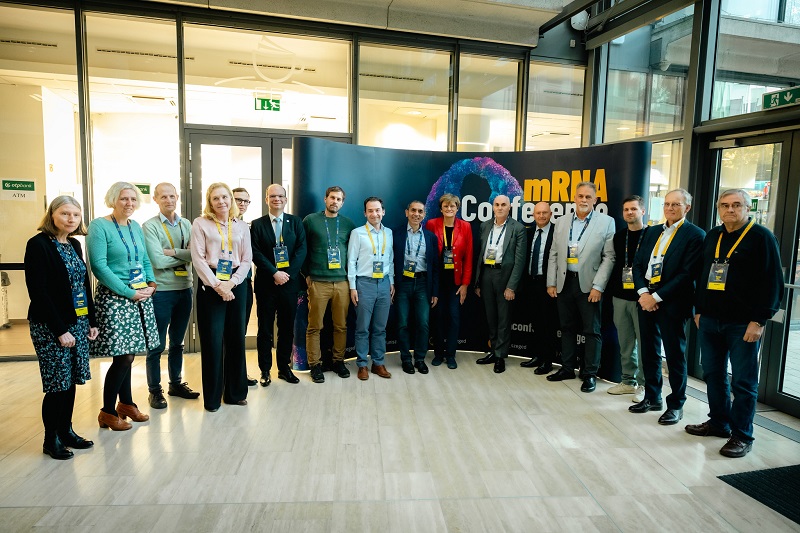
Speakers at the mRNA Conference (from left to right): Persephone Borrow, Katrien Remaut, Robin Shattock, Karin Loré, Nicolas Manel, Zoltán Jakus, Gerald Schwank, Norbert Pardi, Uğur Şahin, Katalin Karikó, Drew Weissman, Martin Ridderstråle, Antal Nógrádi, Rein Verbeke, Jørgen Frøkiær, Tamás Kiss
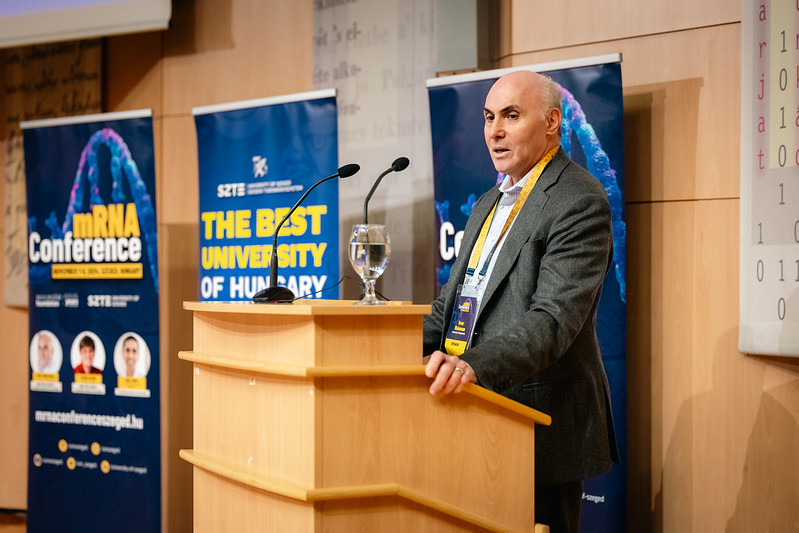
Drew Weissman
Drew Weissman began his presentation by outlining the different methods of vaccine development, noting that traditional vaccines use attenuated viruses to prime the immune system for a possible encounter with the actual virus. In contrast, mRNA vaccines utilize RNA that encodes proteins present in the membranes of bacteria or viruses, prompting the body itself to generate the material necessary to trigger an immune response.
In his presentation, Drew Weissman also shared insights on a groundbreaking immunological discovery regarding the in vivo application of CAR T-cells, that is, T cells with artificially modified surfaces. This technology involves isolating the T cells responsible for the immune response from a blood sample taken from the patient and then artificially placing a specific receptor on their surface. This, in turn, enables the modified T cells to recognize a particular disease once they are reintroduced into the patient’s body. However, since carrying out this procedure under laboratory conditions can be both time-consuming and costly, Drew Weissman and his colleagues are currently exploring ways to place the artificial receptor directly on T cells in the patient’s body. This procedure operates on the same principle as the mRNA vaccine: the mRNA that encodes the receptor is delivered into the T cells in the patient’s body, resulting in the appearance of the specific receptor on the cell surface. These ‘tagged’ cells will then empower the immune system to identify cancer cells or trigger other immune responses in the body.
A key element of the procedure involves packaging the receptor-encoding mRNA into specialized lipid nanoparticles (LNPs) – nano-sized fat droplets, in simple terms. It should be emphasized that different LNPs can target different entities; for instance, in the case of CAR T-cells, LNPs specifically target the T cells that express the receptor on their surface.
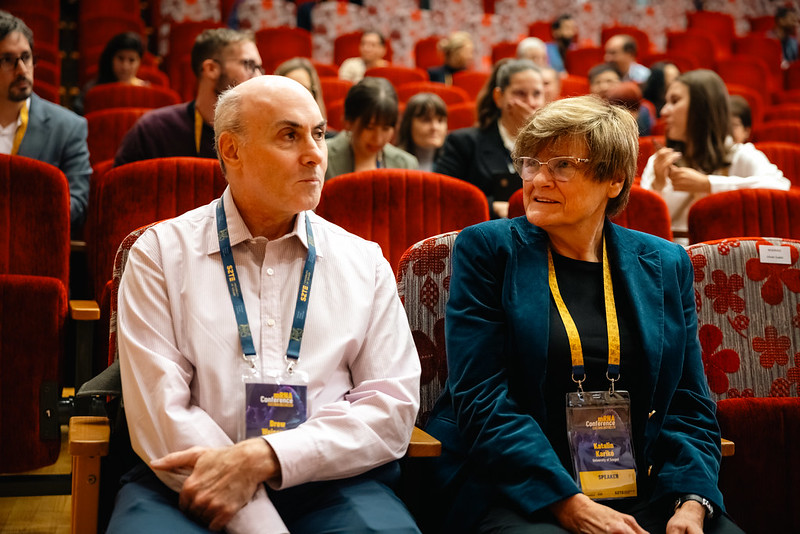
Drew Weissman and Katalin Karikó
Drew Weissman also provided an overview of ongoing research, discussing sickle cell anemia – a genetic disease that affects red blood cells, causing them to adopt a sickle shape. The therapeutic approach to sickle cell anemia is based on the understanding that all cellular components in the blood – including hemoglobin, various coagulation factors, and immune cells – differentiate in the bone marrow. By specifically targeting the bone marrow, where these cells are produced, therapeutic efficacy could be significantly enhanced compared to traditional approaches, which rely on waiting for the cells to develop, enter the bloodstream, and encounter antigens to initiate a response. In other words, by targeting the bone marrow, the goal is to create an mRNA-based product that changes the genome at an early stage, enabling a targeted defense against sickle cell anemia.
In his talk, Drew Weissman also noted that mRNA-based approaches are not limited to treating diseases but are also applied in more delicate therapies. To illustrate, he discussed the protein known as PUMA, which is capable of inducing apoptosis – a genetically programmed process through which a cell self-destructs. The protein can also be delivered into the nuclei of bone marrow cells, where it can trigger apoptosis. This procedure is useful in medical treatments that require the removal of surrounding cells and is also less toxic than chemotherapy agents designed to achieve the same effect.
The American researcher dedicated a segment of his talk to the ethical issues surrounding access to vaccines, focusing on Malaria – a disease particularly prevalent in regions where funding for research is most limited. Drew Weissman has spent years working in Thailand, where the research facility he helped establish played a vital role in supplying manufacturing capacity for Pfizer during the COVID-19 pandemic, addressing the urgent need for the rapid production of large quantities of vaccines. Today, this facility manufactures 10 of its own vaccines targeting various diseases. Drew Weissman also noted that an mRNA distribution center is being established in South Africa to enable the local and efficient production of vaccines for the African continent.
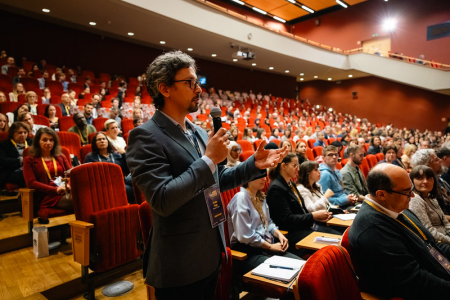  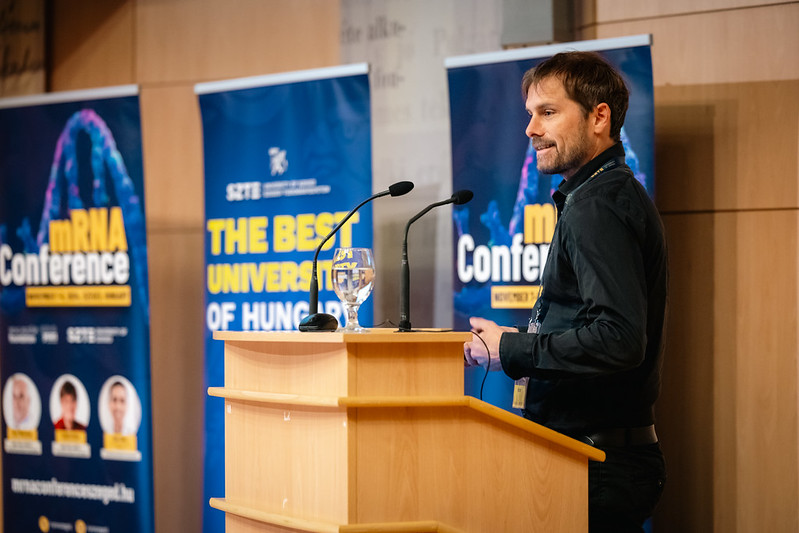 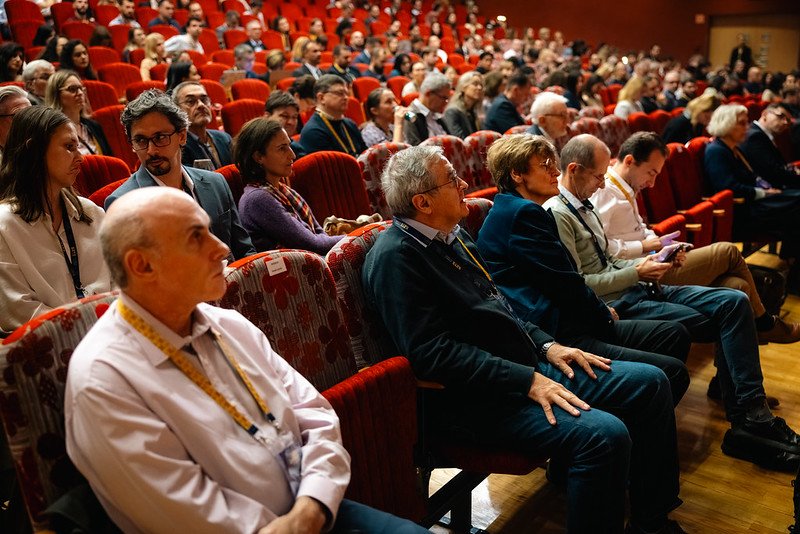  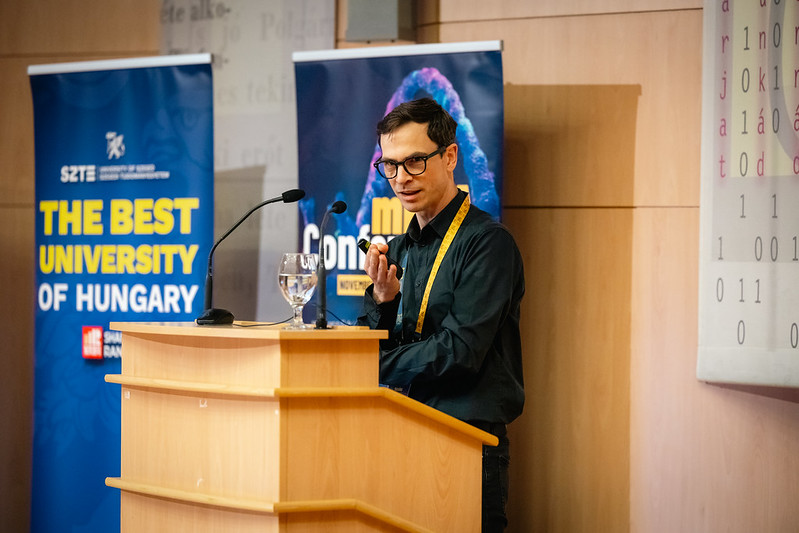        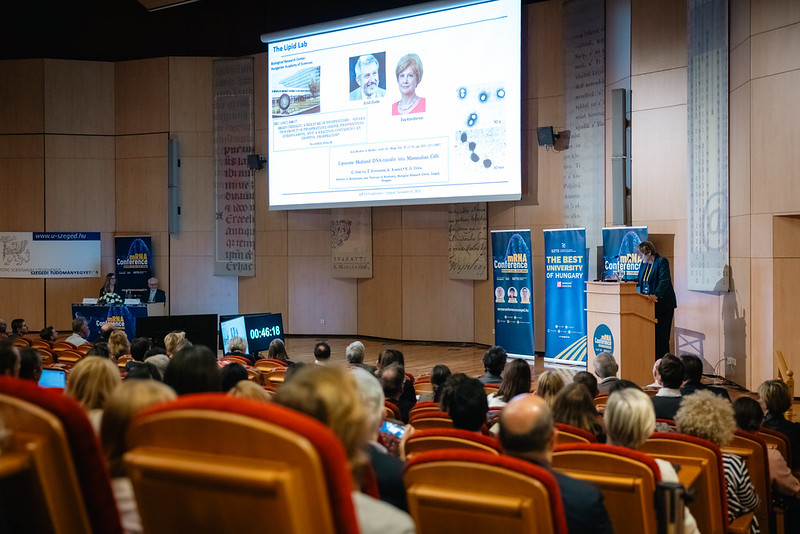 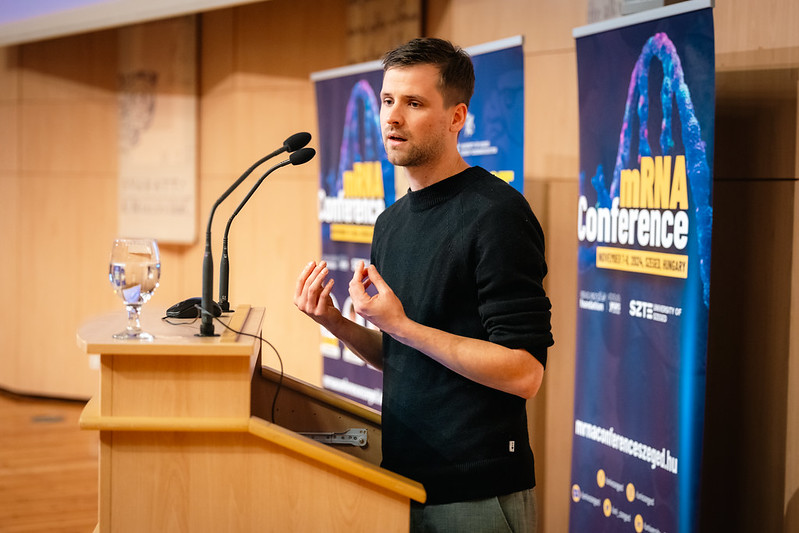 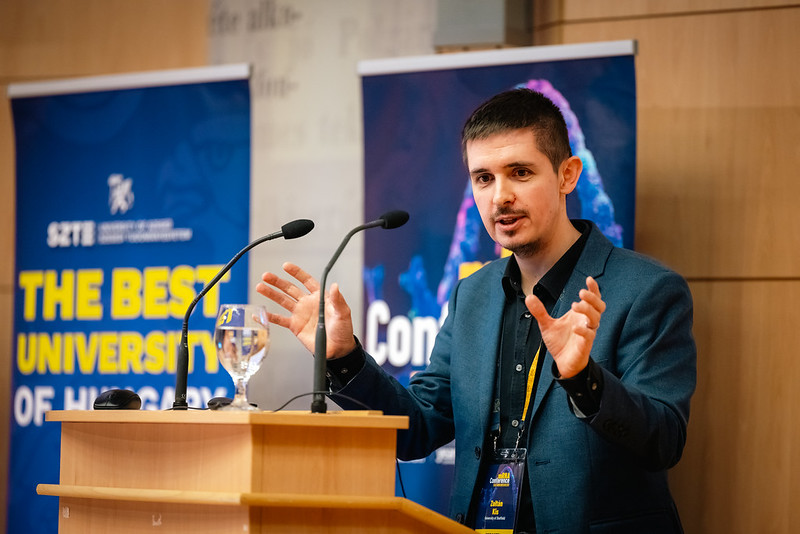   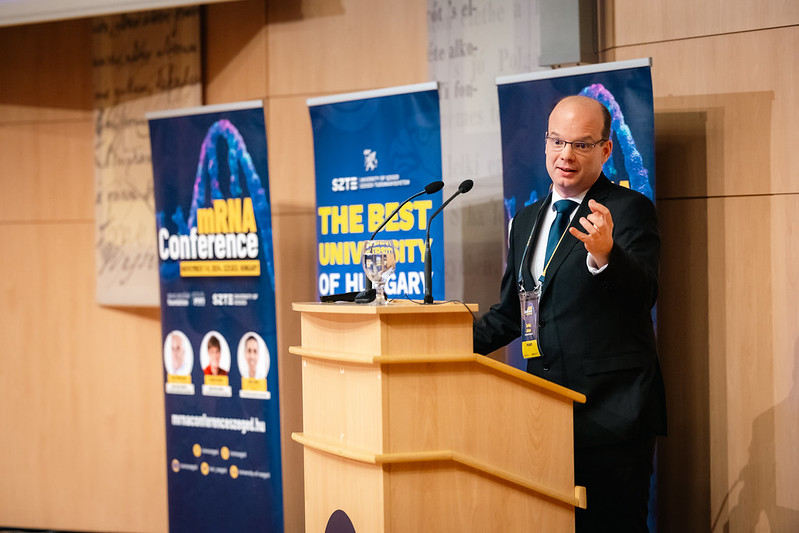     |
| Highlights from the mRNA conference. Photos by Ádám Kovács-Jerney and István Sahin-Tóth |
Karin Loré is currently a professor at the Department of Medicine at the Karolinska Institute in Sweden. She completed her postdoctoral studies in the United States at the NIH Vaccine Research Center. Her research group has extensive experience in evaluating vaccines in their late preclinical phase.
Karin Loré’s presentation focused on how the immune system responds to mRNA. Specifically, she addressed the following questions:
• What types of cells are targeted by mRNA vaccines?
• After administration, how does the distribution of vaccines occur throughout the body?
• Where is their effect concentrated?
• How long does it take for them to elicit the strongest immune response?
• And when does their effect begin to wane?
Karin Loré's research group in Stockholm conducted meticulous measurements to compare immune responses elicited by mRNA vaccines with those elicited by more traditional vaccine platforms, such as the ones utilizing protein adjuvants or inactivated whole viruses. The group’s findings indicate that mRNA vaccines generate a stronger innate immune response compared to their traditional counterparts.
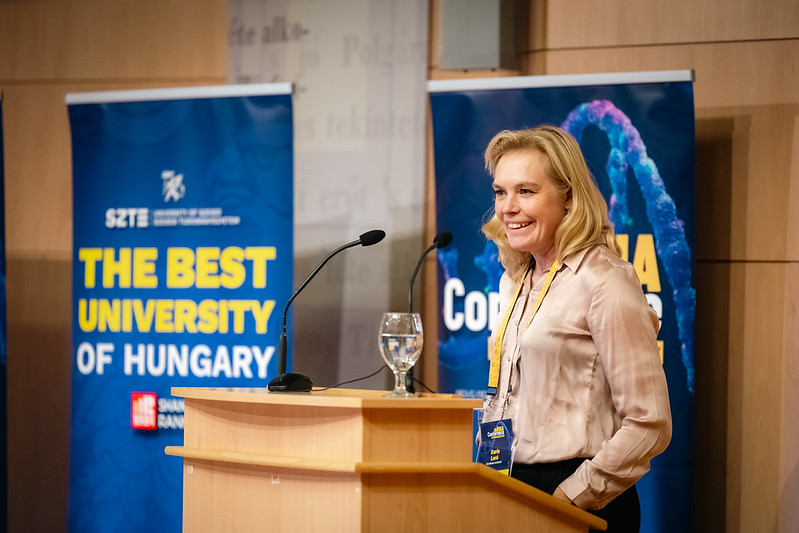
Karin Loré
Karin Loré also highlighted the following questions:
• Which cells take up lipid nanoparticles (LNPs) that encapsulate the mRNA molecule, and how efficient is this process?
• Which cells are the most effective at translating the delivered mRNA into proteins for the human body?
According to the researcher, neutrophil immune cells, which primarily defend against foreign microorganisms, are the most efficient at absorbing lipid nanoparticles. Yet, intriguingly, they exhibit the lowest rate of protein translation. To perform a comparison, Karin Loré’s research team used labeled LNPs and mRNA that codes for signaling proteins, focusing primarily on the delivery of carrier LNPs and the efficiency of protein translation. Their research also explored how LNPs administered via different routes, such as intramuscular or subcutaneous injection, target various lymph nodes, enabling them to reach different locations within the body.
During the examination of COVID-19 vaccines, researchers compared the Pfizer and Novavax vaccines to assess which one triggers the expression of the virus-simulating spike protein more efficiently, and to determine how quickly this effect becomes detectable in the blood. In samples from immunized individuals, the spike protein produced by the mRNA was detectable after just 24 hours in both cases, triggering an immune response. However, the two vaccines induced antigen production through different mechanisms. The researchers also found that a vaccine’s effectiveness is not solely dependent on the quantity of antigen it produces. While the Pfizer vaccine generated a substantial amount of antigen and demonstrated strong efficacy, the Novavax vaccine also proved effective despite producing less antigen.
The presentation also covered the comparison between mRNA-based vaccines and traditional vaccines. Each vaccine targeted the same four influenza virus strains and utilized either mRNA, a weakened virus, or an added adjuvant. Among the three types of influenza vaccines evaluated, the mRNA vaccine exhibited the highest efficacy. Notably, the mRNA vaccine elicited the strongest immune response and was particularly effective in promoting T-cell immunity. Furthermore, the findings paint a positive picture about the mRNA vaccine’s ability to provide immune protection for elderly individuals.
At the Karolinska Institute, Karin Loré’s team also tested an mRNA vaccine targeting the rabies virus. Triggering a more sustained immune response, the vaccine outperformed a traditional vaccine by generating higher levels of neutralizing antibodies and increasing the production of memory B and T immune cells. Moreover, it demonstrated a stronger cross-neutralization effect against other lyssavirus strains.
Karin Loré also shared research insights about determining the optimal concentration of mRNA vaccines. The team’s findings revealed that although the amount of mRNA reaching the lymph nodes varies with dose size, even a 10-microgram dose can elicit a response. She emphasized that targeting the lymph nodes is crucial for effective immunization. Consequently, while the skin contains a higher density of immune cells, administering the vaccine into the muscle is more effective, as it allows the active ingredient to reach a greater number of lymph nodes.
Antal Nógrádi is head of the Department of Anatomy, Histology, and Embryology at the Albert Szent-Györgyi Medical School, University of Szeged, and oversees the Neuroregeneration Laboratory, which has been investigating therapeutic approaches for spinal cord injuries for many years.
In his presentation, he highlighted the challenges of effectively delivering therapeutic proteins in vivo to modulate the microenvironment of injured spinal cord tissue and promote both neuroprotection and regeneration. To address these challenges, his team employed nucleoside-modified mRNA technology to deliver therapeutic protein-encoding mRNAs. Their experiments utilized mRNAs encapsulated in lipid nanoparticles (LNPs) designed to encode components of a previously studied secretome. Earlier research had shown that proteins within this secretome facilitated neuroprotection and functional recovery in rats with spinal cord injuries. This method resulted in enhanced axonal regeneration, reduced inflammation, and a significant reduction in the size of secondary cystic cavities.

Antal Nógrádi
Antal Nógrádi’s presentation shed light on the inflammatory processes triggered by spinal cord injuries caused by impact. He explained that such injuries set off two distinct waves of inflammation. In the first phase, macrophage cells quickly rush to the site of the injury. Then a second wave of macrophages arrives 6-7 days later, after scarring has begun. This subsequent phase of inflammation contributes to cavity formation, which significantly impedes recovery. Importantly, the critical window for therapeutic intervention is between days 7 and 14, before the body begins replacing damaged cells with non-functional scar tissue – a process that results in permanent neurological dysfunction.
In earlier studies, Antal Nógrádi and his research team explored the immunological signaling molecules released by stem cells implanted into spinal cord injuries. Among these molecules were IL-6 and IL-10. Their experiments demonstrated that IL-10 not only exhibits strong anti-inflammatory properties but also provides significant neuroprotective effects.
In his presentation, the researcher also reported that during their stem cell implantation experiments, the research group developed a polycistronic cassette – a DNA construct encoding multiple cytokines believed to positively influence injury recovery. They then selected four proteins for further exploration: IL-6, IL-10, MIP-1ALFA, and GDNF.
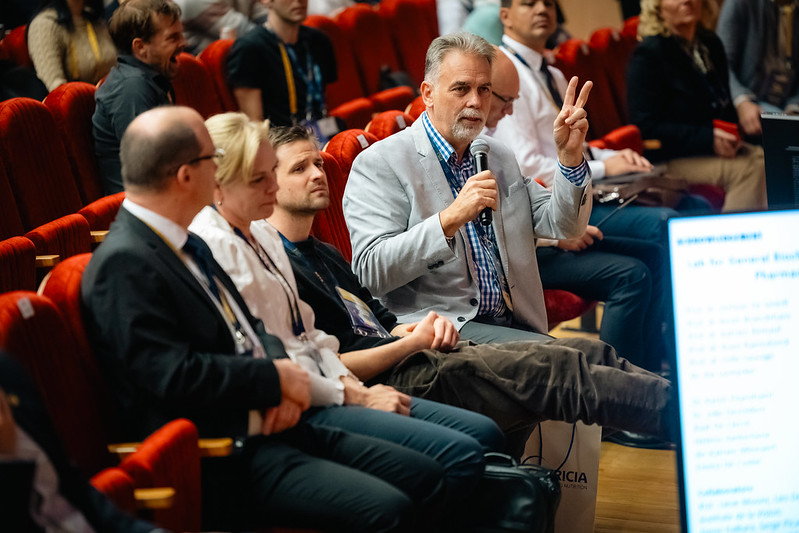
Antal Nógrádi’s research group first employed the mRNA-based method in 2019, aiming to stimulate cells near the injury site to produce IL-10, the protein demonstrating the most beneficial effects. At the time, Norbert Pardi’s research team at the University of Pennsylvania had already made significant advancements in developing lipid nanoparticles (LNPs) for mRNA delivery. This prompted Nógrádi to reach out to Pardi.
In initial experiments by the two groups, LNP-encapsulated mRNA encoding the IL-10 protein was directly injected into the area surrounding the spinal cord injury. Dosing was carefully controlled to avoid exacerbating the lesion. Using a camera-based system to monitor and analyze the complexity of the animals’ movements, the team observed notable improvements in the experimental rats. Moreover, they found that administering the IL-10-encoding mRNA-LNP nanoparticles within the critical time window restored the animals’ movements to a near-natural state.
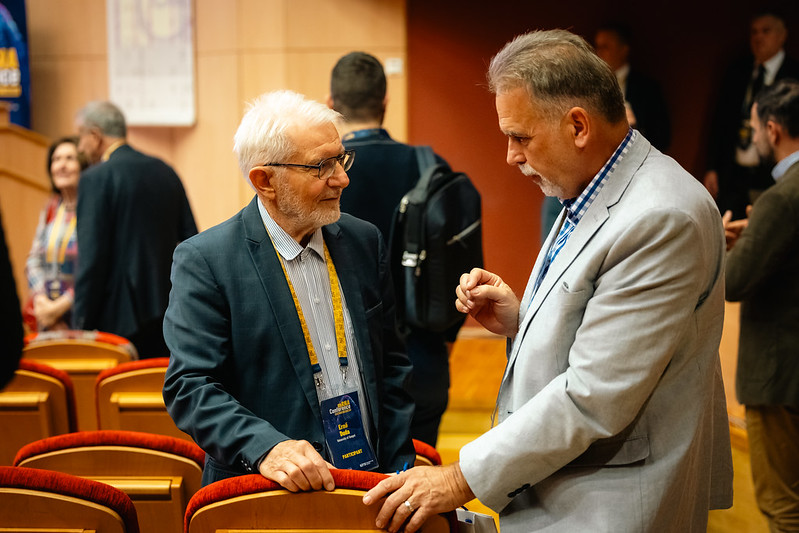
Ernő Duda and Antal Nógrádi
In another experiment conducted by Nógrádi and his colleagues, animals were administered mRNA encoding all four of the selected proteins. This approach led to even greater improvements in the movement of rats with spinal cord injuries. Following Nógrádi’s presentation, Uğur Şahin inquired about the role of IL-6, a pro-inflammatory cytokine, in the injury. Nógrádi’s response revealed that this protein plays a markedly different role in the nervous system compared to its role in the blood or other organs.
Antal Nógrádi also highlighted his team’s latest research, which involves delivering mRNA not directly to the site of the spinal cord injury but rather to the abdominal cavity. This approach takes advantage of certain cells that reside there in a state of readiness, capable of migrating to the injury site in response to specific signals and exerting their therapeutic effects. (A detailed interview with Antal Nógrádi on his research will be featured here soon.)
Uğur Şahin is a researcher and physician who co-founded BioNTech in Mainz, Germany, alongside Özlem Türeci and Christoph Huber. Building on Katalin Karikó's pioneering mRNA technology, he and his team developed the Pfizer-BioNTech COVID-19 vaccine in January 2020. This vaccine became the first COVID-19 vaccine authorized for use worldwide.
In his presentation, Uğur Şahin highlighted a groundbreaking approach to cancer treatment: an mRNA-based method utilizing neoantigens. This method allows for the prediction of potential tumor mutations, paving the way for personalized therapies tailored to individual cancer patients.

Uğur Şahin
Antigens are proteins on the surface of cancer cells that the immune system recognizes as foreign, triggering a defensive immune response against them. However, earlier therapies utilizing antigens have shown limited effectiveness, as tumors often evolve into resistant sub-tumors capable of evading the immune system. This underscores the need for treatments that can equip the immune system to respond effectively to emerging mutations.
To address this challenge, neoantigen therapy begins by collecting a tumor sample to extract information about the tumor’s existing state, which is then used to predict potential future mutations. This data is subsequently encoded into messenger RNA (mRNA). The resulting neoantigen protein is recognized by the immune system as foreign, prompting it to target and destroy cancer cells that display these neoantigens on their surface.

Interestingly, artificial intelligence can be utilized at every stage of therapy. Among other things, it can identify tumor antigens, assist in designing personalized mRNA, and monitor effectiveness during follow-up. However, this technology is only viable for certain tumor types with lower mutation rates, as mRNA can only encode a limited number of mutations.
Uğur Şahin illustrated the potential pitfalls of the technology with specific examples, emphasizing the importance of paying meticulous attention to every detail during treatment. In one case, for instance, a sample was taken from a breast cancer patient but only from the tumor in one breast. It was later discovered that the tumor in the other breast was of a different type, rendering the therapy ineffective for it. He also pointed out the possibility of tumors concealing the antigen-presenting ‘identification molecule’ that helps the immune system distinguish between the body’s own cells and those it needs to attack.
With over 30 years of experience in developing vaccines and anti-infective agents, Robin Shattock is a professor at Imperial College London, where he heads a vaccine development center in collaboration with international partners.
In his presentation, Robin Shattock emphasized that mRNA-based vaccines have proven highly effective in eliciting strong immune responses against COVID-19, coupled with rapid and relatively simple manufacturing processes. He also suggested that self-amplifying RNA (saRNA) vaccines could provide even greater benefits in the future.
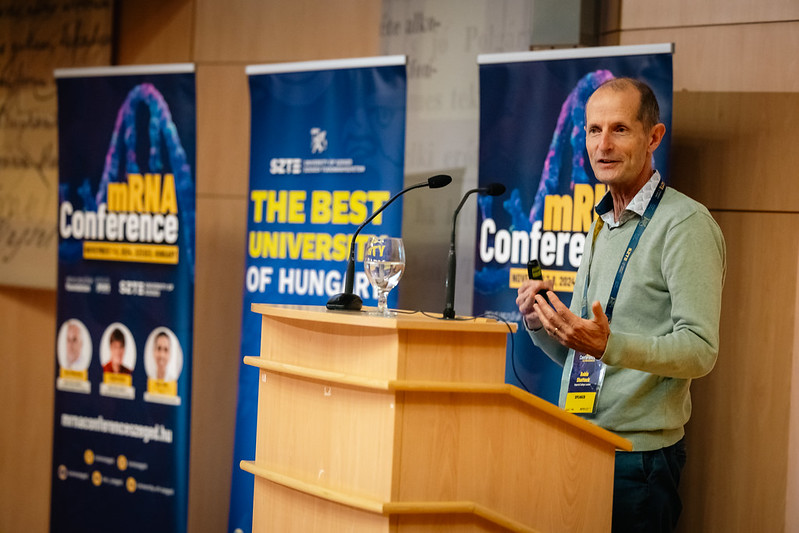
Robin Shattock
The key feature of self-amplifying RNA (saRNA) is its ability to replicate itself within the cell. In conventional mRNA technology, mRNA is delivered using lipid nanoparticles. Once inside the cell, it produces its intended effect by being translated into a protein and then degrades. In contrast, saRNA remains active in the cell for several weeks, continuously replicating itself while fulfilling the same role as mRNA in encoding the protein.
Robin Shattock explained that the continuous replication of RNA is driven by a protein derived from the genome of an alphavirus. Naturally, this is a modified, non-infectious part of the virus. This design makes the system highly controllable, as researchers have a precise understanding of this genome, enabling them to predict how many weeks the saRNA will persist and replicate within the cell.
While mRNA introduced into the body breaks down within a few days, self-amplifying RNA (saRNA) does not. This characteristic can be both an advantage and a disadvantage. For instance, in protein replacement therapies for rare genetic diseases, mRNA would need to be administered weekly to ensure continuous production of the missing protein. In contrast, the prolonged effect of saRNA allows for constant protein production, significantly reducing the frequency of treatments required for the patient. Robin Shattock also noted, however, that mRNA encapsulated in lipid nanoparticles remains an excellent option for tackling seasonal illnesses and pandemics due to its quick and simple production and its efficiency in the delivery of therapeutic benefits.
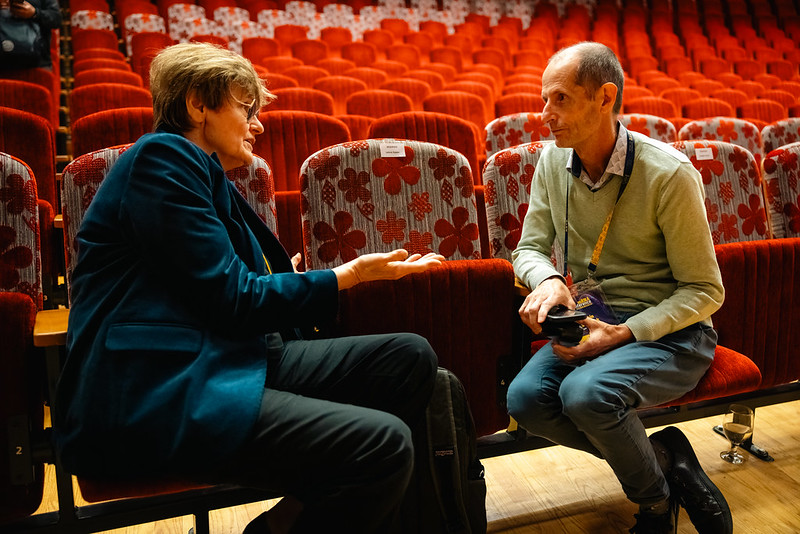
Currently, there are no approved therapies based on self-amplifying RNAs (saRNAs). This is because saRNA requires different modifications compared to mRNA modification, which only involves the pseudouridine modification discovered by Katalin Karikó and Drew Weissman. In the case of saRNA, alongside uridine modification, a 2'O-methyl modification is also necessary. This improves stability, increases expression, and reduces the inflammatory response to RNA. However, manufacturing saRNA is significantly more challenging than producing mRNA.
In his presentation, Robin Shattock explained that the formulation of saRNA also differs from that of mRNA: instead of being encapsulated in lipid nanoparticles (LNPs), saRNA is typically packaged in polymers. He also pointed out that the immune response to saRNA was studied using human skin explant models to determine which specific cells are capable of taking up this RNA formulation. Nevertheless, as with mRNA, saRNA therapy is also designed to be administered intramuscularly.
Conducting animal studies, Robin Shattock observed that the initial dose of self-amplifying RNA elicited only a minimal response. However, following the second, booster dose, the animals demonstrated a significantly enhanced immune response, comparable to that achieved with mRNA vaccines.
Robin Shattock noted that, due to Brexit, there was uncertainty at the onset of the COIVD-19 pandemic about whether the United Kingdom would procure vaccines through the European Union or produce its own. For a time, it seemed that the development of an saRNA vaccine would become Britain’s solution. However, with the emergence of the BioNTech-Pfizer vaccine, domestic funding for the project was cut off.
Persephone Borrow is a professor of viral immunology and Deputy Director of the Centre for Immuno-Oncology at the Nuffield Department of Medicine, University of Oxford. She is also affiliated with the Duke Human Vaccine Institute at Duke University in the United States. Her current research focuses on testing vaccines and therapies for HIV and other diseases, with a particular emphasis on understanding how HIV evades the immune system and how chronic infections impact immune function.
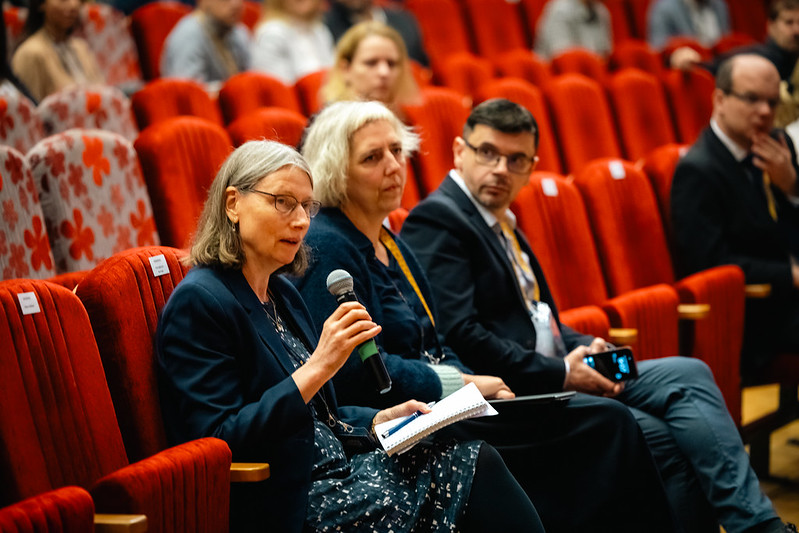
Persephone Borrow speaking at the event
In her presentation, Persephone Borrow discussed ionizable nanoparticles intended for use in vaccines against the HIV virus. She highlighted the well-known fact that mRNA vaccines induce the production of neutralizing antibodies in the body, which, in turn, can modulate the immune system to mount an effective response against the virus. The professor also compared the variability of the influenza virus to the diversity of the HIV virus.
The purpose of developing an HIV vaccine is to induce the production of so-called broadly neutralizing antibodies (bNAbs). bNAbs can recognize and block many strains of HIV, preventing them from entering healthy cells. Research indicates that bNAbs can also activate other immune cells, such as CD8-positive T cells, to help destroy HIV-infected cells. Persephone Borrow also noted that vaccines combining mRNA with ionizable lipid nanoparticles (LNPs) have led to increased activation of CD4 and other regulatory cells. In simpler terms, these vaccines activate adaptive immune cells that can then fight against the HIV virus.
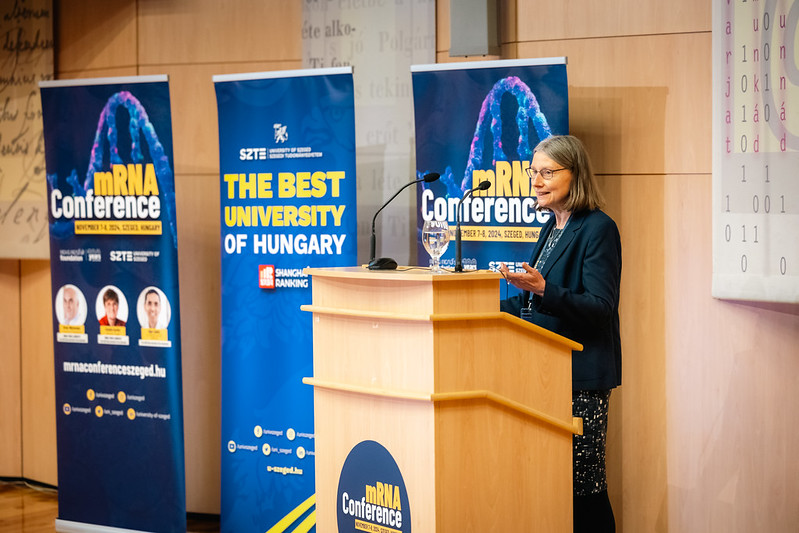
The novelty of ionizable lipid nanoparticles (LNPs) lies in their ability to elicit a much stronger immune response than non-ionizable LNPs do. With non-ionizable LNPs, vaccines require the addition of adjuvants – substances that enhance the immune response. Persephone Borrow noted that the use of adjuvants often triggers a strong innate immune response, such as inflammation. In contrast, ionizable LNPs significantly reduce this inflammatory reaction. The primary goal of vaccination is to maximize the production antibodies and memory cells. However, if the immune system reacts directly to the RNA itself, this process may be hindered.
Tamás Kiss is Director of Research at the National Institute of Health and Medical Research (INSERM) in France. He is also an elected member of the European Molecular Biology Organization and a Doctor of the Hungarian Academy of Sciences. He has made groundbreaking discoveries in the field of RNA biology, including the identification of small nucleolar RNAs (snoRNAs) encoded by introns and the exploration of their roles in RNA modification. His research has also advanced the understanding of RNA functions, such as the regulation of mRNA production by small nuclear RNAs (snRNAs) and the cellular roles of orphan snoRNAs.
In his presentation, Tamás Kiss explained that eukaryotic cells (those with a nucleus) undergo extensive site-specific post-transcriptional covalent modifications in their RNAs, which play a crucial role in gene expression control. These modifications predominantly occur in metabolically stable RNAs (such as rRNA, tRNA, and snRNA), but they are also found in mRNAs, where they tend to be clustered in functionally important RNA regions. The researcher’s presentation provided a comprehensive overview of his pioneering research on the molecular mechanisms, evolutionary origins, and biological benefits of RNA-guided modifications.
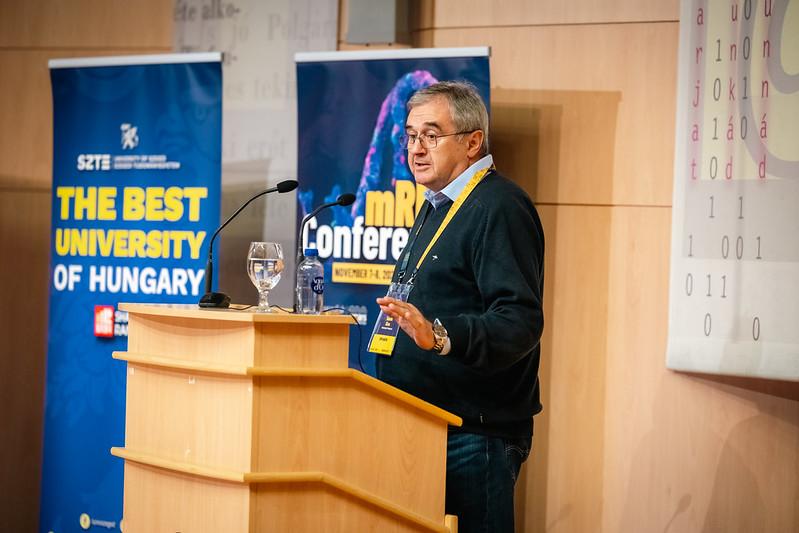
Tamás Kiss
In addition to messenger RNA, cells contain numerous non-coding RNAs, each with specific functions. Some of these RNAs remain in the nucleus after transcription – the process of copying information from the genetic code – rather than being transported to the cytoplasm like mRNA. Such RNAs include small nuclear RNAs (snRNAs) and small nucleolar RNAs (snoRNAs), which localize in the nucleolus. The nucleolus is not a well-defined anatomical structure but rather a region within the nucleus characterized by distinct molecular compositions. Focusing on these unique RNAs, Tamás Kiss was among the first to describe the function of snoRNAs.
Among other areas, Tamás Kiss’s research explores RNA-guided post-transcriptional modifications such as pseudouridylation and 2'-O-methylation. One of his intriguing discoveries is that transfer RNAs (tRNAs) and ribosomal RNAs (rRNAs) naturally contain the same pseudouridine and 2'-O-methylation modifications that Katalin Karikó and Drew Weissman artificially introduced into mRNA molecules.
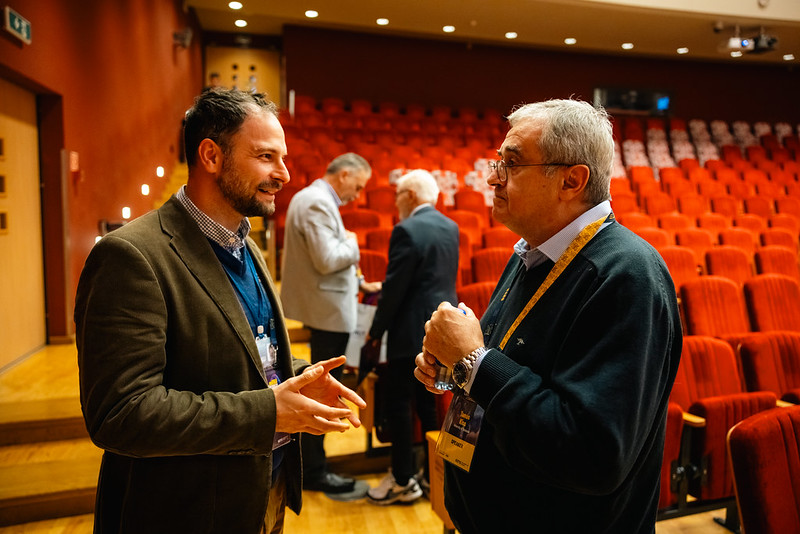
Biologist István Prazsák and Tamás Kiss
What are the functions of snRNA and snoRNA molecules? Tamás Kiss addressed this question by explaining that when certain snoRNAs were removed from specific cells, the corresponding methylation was lost; while in other cases, the removal of snoRNAs led to the loss of pseudouridine modifications. These observations led him to conclude that small nucleolar RNAs modify ribosomal RNAs through methylation or pseudouridylation. Further in-depth studies revealed that eliminating the essential C/D box regions of snoRNAs completely abolished both types of modifications. According to Tamás Kiss, it remains unclear what the biological purpose of these modifications is when they occur naturally, rather than being artificially induced.
In his presentation, Tamás Kiss also discussed a research project still in its early stages, noting that many additional small RNAs have been discovered beyond the original five identified earlier. Among other things, the significance of small RNAs lies in the fact that some of them, once activated, can induce tumor formation in various organs, while others may play a role in tumor suppression.
One of the conference’s highlights was Tamás Kiss’s current research on the Epstein-Barr virus, which is linked to approximately 10 percent of cancer cases. His findings suggest that the virus is capable of using its own snoRNA to modify the host cell’s RNA, thereby facilitating virus replication. What makes this phenomenon particularly remarkable is that the virus does not utilize its snoRNA for any purpose until the infection occurs. (An interview with Tamás Kiss on his research will be featured here soon.)
To be continued.
Original Hungarian text by Sándor Panek and Helga Balog
The writers would like to express their gratitude to PhD students Dóra Adamecz, Máté Csikós, Csaba Papp, Zóra Szilovics, Zsolt Tasi, and Éva Veres from the Institute of Biology, University of Szeged, for their invaluable contributions.
The feature photo shows Uğur Şahin, Katalin Karikó, and Drew Weissman. Photos by Ádám Kovács-Jerney, István Sahin-Tóth
Previous articles on the mRNA Conference:
Countdown to the mRNA Conference: University of Szeged rolls out the red carpet
Fueling innovation: Why Novo Nordisk Foundation is backing the Szeged mRNA Conference
A real eye-opener: Coursera’s free course on mRNA
New advances in mRNA research spark hope – one year after Katalin Karikó’s Nobel Prize win
University of Szeged to host two-day conference on the ‘Swiss Army knife’ of medical science

